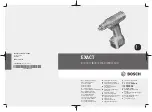
DO NOT RETURN THIS PRODUCT TO THE STORE,
first contact your local STANLEY Office
or nearest authorized service center.
Intended Use
This STANLEY screwdriver has been designed for driving
drywall fasteners through drywall board into timber or metal
framing studs.
General Safety Rules
Warning!
Read and understand all instructions.
Failure to follow all instructions listed below, may
result in electric shock, fire and/or serious
personal injury.
Save These Instructions
Safety instructions
General power tool safety warnings
Warning! Read all safety warnings and all
instructions.
Failure to follow the warnings and
instructions listed below may result in electric shock, fire
and/or serious injury.
Save all warnings and instructions for future reference.
The term "power tool" in all of the warnings listed below
refers to your mains operated (corded) power tool or battery
operated (cordless) power tool.
1. Work area safety
a. Keep work area clean and well lit.
Cluttered or dark
areas invite accidents.
b. Do not operate power tools in explosive
atmospheres, such as in the presence of flammable
liquids, gases or dust.
Power tools create sparks
which may ignite the dust or fumes.
c. Keep children and bystanders away while operating
a power tool.
Distractions can cause you to lose
control.
2. Electrical safety
a. Power tool plugs must match the outlet. Never
modify the plug in any way. Do not use any adapter
plugs with earthed (grounded) power tools.
Unmodified plugs and matching outlets will reduce risk
of electric shock.
b. Avoid body contact with earthed or grounded
surfaces such as pipes, radiators, ranges and
refrigerators.
There is an increased risk of electric
shock if your body is earthed or grounded.
c. Do not expose power tools to rain or wet conditions.
Water entering a power tool will increase the risk of
electric shock.
d. Do not abuse the cord. Never use the cord for
carrying, pulling or unplugging the power tool. Keep
cord away from heat, oil, sharp edges or moving
parts.
Damaged or entangled cords increase the risk of
electric shock.
e. When operating a power tool outdoors, use an
extension cord suitable for outdoor use.
Use of a cord
suitable for outdoor use reduces the risk of electric
shock.
f. If operating a power tool in a damp location is
unavoidable, use a residual current device (RCD)
protected supply.
Use of an RCD reduces the risk of
electric shock. Note: The term “Residual Curent Device
(RCD)” can be replaced by “Ground Fault Circuit
Interrupter (GFCI)” or by “Earth Leakage Circuit Breaker
(ELCB)”.
3. Personal safety
a. Stay alert, watch what you are doing and use
common sense when operating a power tool. Do not
use a power tool while you are tired or under the
influence of drugs, alcohol or medication.
A moment
of inattention while operating power tools may result in
serious personal injury.
b. Use personal protective equipment. Always wear eye
protection.
Protective equipment such as dust mask,
non-skid safety shoes, hard hat, or hearing protection
used for appropriate conditions will reduce personal
injuries.
c. Prevent unintentional starting. Ensure the switch is
in the off-position before connecting to power
source and/or battery pack, picking up or carrying
the tool.
Carrying power tools with your finger on the
switch or energising power tools that have the switch on
invites accidents.
d. Remove any adjusting key or wrench before turning
the power tool on.
A wrench or a key left attached to a
rotating part of the power tool may result in personal
injury.
e. Do not overreach. Keep proper footing and balance
at all times.
This enables better control of the power tool
in unexpected situations.
f. Dress properly. Do not wear loose clothing or
jewellery. Keep your hair, clothing and gloves away
from moving parts.
Loose clothes, jewellery or long hair
can be caught in moving parts.
ENGLISH
4
(Original instructions)
Summary of Contents for STDR5206
Page 1: ...STDR5206 English Page 3 Russian Page 13 Ukrainian Page 23...
Page 2: ...ENGLISH 2 Original instructions FIG A FIG B FIG C 4 5 5 3 1 2 4 5 6 FIG D FIG E 5 6 7 8 1...
Page 3: ...3 ENGLISH Original instructions FIG F FIG H FIG J FIG G FIG I FIG K 1 1 2 2 2 10 7 8 9...
Page 11: ...11 FIG A FIG B FIG C 4 5 5 3 1 2 4 5 6 FIG D FIG E 5 6 7 8 1...
Page 12: ...12 FIG F FIG H FIG J FIG G FIG I FIG K 1 1 2 2 2 10 7 8 9...
Page 13: ...13 STANLEY 1 b 2 b d f 3 a b d...
Page 14: ...14 f g 4 a b c d c f 5 7 STANLEY STANLEY A 1 2 3 4 5 6 A n0 6 II 2014 XX JN...
Page 15: ...15 ANSI Z87 1 ANSI Z87 1 14 15...
Page 17: ...17 1 2 3 4 G 1 2 1 1 4 2 3 4 H I J 1 16 1 6 K 1 a 2 b...
Page 18: ...18 STDR5206 520 220 240 50 60 0 4500 3 3 1 45...
Page 21: ...21 FIG A FIG B FIG C 4 5 5 3 1 2 4 5 6 FIG D FIG E 5 6 7 8 1...
Page 22: ...22 FIG F FIG H FIG J FIG G FIG I FIG K 1 1 2 2 2 10 7 8 9...
Page 23: ...23 STANLEY 1 b 2 b d f 3 a b d f...
Page 24: ...24 g 4 a b c d f 5 7 STANLEY STANLEY A 1 2 3 4 5 6 A n0 II 2014 XX JN...
Page 27: ...27 G 1 2 1 1 4 2 3 4 H I J 1 16 1 6 K 1 a 2 b...
Page 28: ...28 STDR5206 520 220 240 50 60 0 4500 3 3 1 45...





































